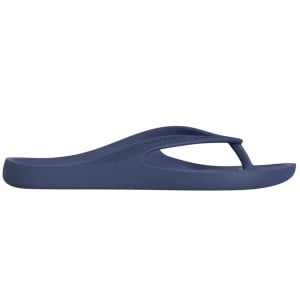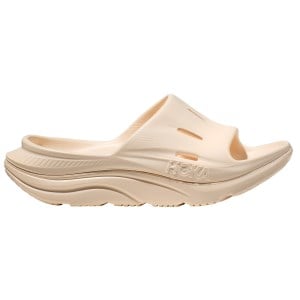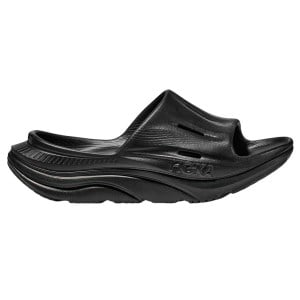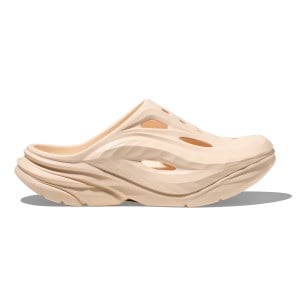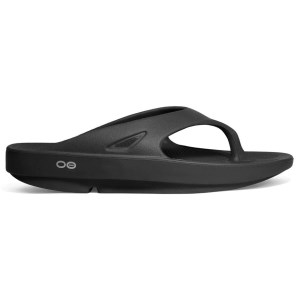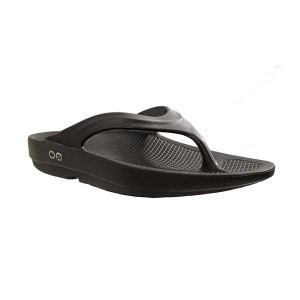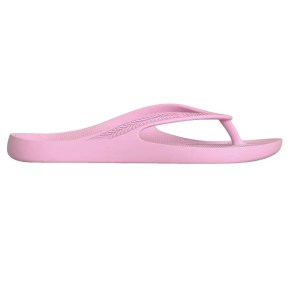Get Rid Of Plantar Fasciitis: Why Every Runner Needs Recovery Shoes
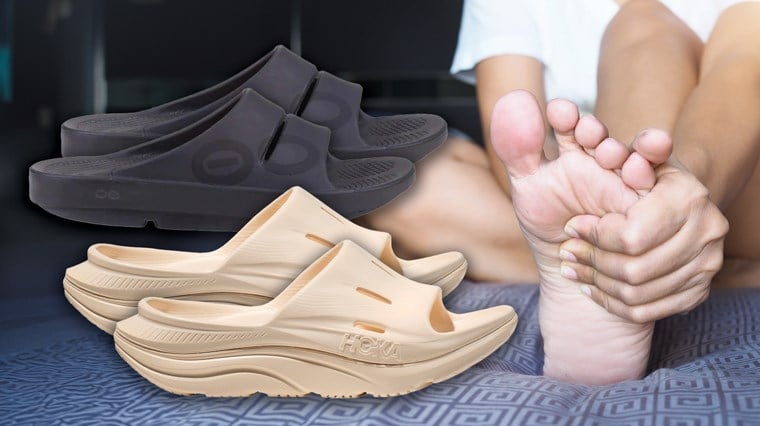
As experts in running, the majority of Sportitude’s focus goes towards setting you up with the best running shoes for you - from our running shoe reviews on the Sportitude YouTube channel to our RunDNA shoe fitting technology in-store at Sportitude Running at Hindmarsh.
In this article we’re going to flip the switch and turn our attention to recovery shoes. From magnesium to massage guns, prioritising your recovery from the inside out and understanding its role in your performance is an essential part of every running plan. Today we’re going to put your feet first by sharing our expertise on recovery shoes to protect your bones and ligaments from the ground up.
We’ll put a brand spotlight on the recovery footwear that has made its mark on the running world - putting a focus on the ever-reliable OOFOS recovery shoes with their pillow-soft protection from heel-to-toe. We'll also introduce you to Hoka shoes - a max cushioned running shoe brand that continues to climb in popularity as it enters the recovery space with their supportive Hoka slides.
Hoka and OOFOS are the royalty of recovery shoes. In the recovery shoe race of OOFOS vs Hoka, we'll give you the information you need to determine which is the right fit for you, and provide a shoe review that highlights the technology and vision behind each brand.
We'll also touch on the Lightfeet Revive recovery thongs as a budget-friendly option to dip your toes into the recovery shoe category and make it more accessible to every runner.
But first, if you've ever said "my plantar fasciitis is killing me", you're not alone. We'll provide insight on what recovery thongs and slides can do for you to prevent common running injuries like plantar fasciitis and to improve the health and wellbeing of your feet.
-
Lightfeet Revive Unisex Recovery Thongs
-
OOFOS OOAHH Sport - Unisex Recovery Slides
-
Hoka Ora Recovery Slide 3 - Unisex Slides
What Is Plantar Fasciitis?
Plantar fasciitis is a common running injury related to the inflammation of the plantar fascia. It feels like a sharp, dull, stabbing or burning pain/tightness at the heel or arch of the foot and is generally the most painful when taking your first steps out of bed in the morning. Symptoms may develop gradually or instantly after rigorous training or as you increase your training load.
Your plantar fascia is the tough, weight-bearing connective tissue that runs from your heel bone (calcaneus), through the arch of your foot and to the base of the toes. It has a critical role in your biomechanics, providing natural shock absorption and aiding in propulsion during movement. Whether you’re walking, jogging, running or jumping, your plantar fascia is at work to support your stride from heel-to-toe and to help you push-off from the road.
Running increases the load of stress on the tendons, ligaments and bones of your feet, applying force that’s up to three times the equivalent of your bodyweight. Repetitive impacts, particularly on hard road surfaces, can be responsible for overuse injuries like plantar fasciitis.
The way you strike the pavement (heel strike, midfoot strike or forefoot strike) and your foot type (neutral, overpronated/flat arched or supinated/high arched) can also influence how this shock is distributed and whether it is done so in an efficient and effective way.
Your plantar fascia can become overstressed for multiple reasons, including:
- Overuse and overtraining
- Overpronation (flat feet - roll inwards) or under pronation (high arched feet - roll outwards)
- Increasing your mileage or speed too rapidly
- Running on hard surfaces like roads
- Wearing running shoes that don’t provide adequate support and cushioning for your foot type
- Running during pregnancy - this can be safe and beneficial with the guidance of your doctor, but these changes to your body can also place greater stress on the arches of your feet and increase your risk of plantar fasciitis
Runners may also be more susceptible to plantar fasciitis when running uphill, doing speedwork or training for long distance events like your next marathon.
Running has positive benefits on your mind and body, so by no means does this mean you should avoid your favourite sport, but taking precautions to prevent plantar fasciitis is in the best interest of your feet.
Wearing the best running shoes for you that offer optimal support and cushioning for your feet and knowing when to replace your running shoes is a game-changer for both road running and trail running. However, how you support your recovery is just as vital to assist in injury prevention.
The solution is just under your feet! Too many of us are in the habit of kicking off our running shoes after rigorous training and slipping into flat, unsupportive everyday thongs. To love your feet back, recovery shoes can make all the difference in plantar fasciitis prevention, relief and may encourage faster healing.
What Are Recovery Shoes?
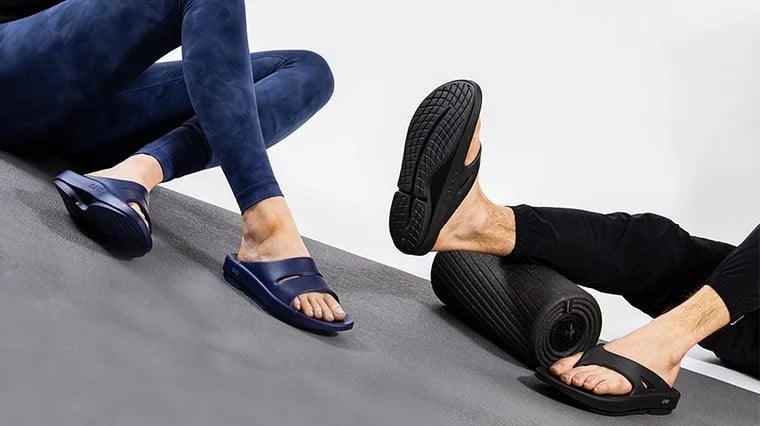
Recovery shoes are engineered with your natural biomechanics in mind, allowing your feet to move and toes to splay naturally with flexible, foot-conforming designs and contoured footbeds. A soft, cradled feel underfoot reduces pressure, with specialised foam compressing beneath your feet in every stride to soak up impact forces.
This shock-absorbing cushioning is at the heart of what makes a good recovery shoe - helping counteract the effects of running on hard road surfaces, which over time can be detrimental to your feet and cause common running injuries like plantar fasciitis.
Recovery shoes often come in slip-on styles like recovery thongs, recovery slides or sandals. They allow your feet to breathe and prevent blister-causing conditions created by sweat, friction, hot spots and poor air circulation. During long runs your feet tend to swell, making slip-on recovery shoes beneficial in giving your beat-up feet a break from enclosed shoes that can make your feet feel squashed, suffocated or restricted.
By no means should recovery footwear be compared to your run-of-the-mill thongs. Recovery shoes are named accordingly, featuring comfortable materials that won’t pinch or chafe sensitive skin. They offer a boost in arch support, helping distribute pressure evenly from heel-to-toe, stabilising your movement and aligning your feet, ankles, knees, hips and back from the ground up for a healthy neutral posture.
Essentially, recovery shoes give your feet a break from the stresses exercise and everyday activity put them under. Recovery shoes are so much more than a treat or a luxury. For runners that have tried recovery shoes, they’re an essential part in caring for your feet to take your training to the next level.
Are Recovery Shoes Worth It?
Yes! Recovery shoes from top brands like OOFOS and Hoka do work, offering post-workout comfort for your feet. They help them feel refreshed and rejuvenated to bounce back faster after your runs and keep you primed for your next road session.
They’re a must-have for everyone with an active lifestyle – from trail blazers updating their ultramarathon survival kit, to recreational runners chasing a PB. Anyone that stands all day on the job such as our amazing nurses and people in the hospitality industry will benefit from having the best recovery shoes on their feet.
For competitive runners, racing shoes tend to provide a snugger, more precise fit around the toe box, so recovery shoes that offer wriggle room will allow your toes to breathe a sigh of relief after you cross the finish line. For long distance runners like marathoners, they cradle your feet in a cushioned platform - supporting repair by reducing stress underfoot after enduring repetitive impacts on the road.
A runner shouldn't skip stretching major muscle groups after intense training, and just as importantly they shouldn’t neglect their hard-working feet. Your feet are the foundations of healthy mobility, posture and balance - the only point of contact you have with the ground to support your entire body when you walk, jog or run your way to better health and fitness.
There are numerous benefits to wearing recovery shoes not only out and about but to protect your feet at home, providing soft cushioning to go about your day, alleviate aches and prevent flare-ups of plantar fasciitis.
Hoka Recovery Shoes vs OOFOS Recovery Shoes
By pairing your feet with the right recovery shoes for you, you're not only reducing your risk of injury, but supporting your performance to crush your running goals and enjoy everyday comfort - because you shouldn't have to live in pain.
Below, we discuss the difference between OOFOS and Hoka recovery shoes, providing a shoe review of each to highlight their key technologies and equally importantly, their signature feel and how it affects your comfort.
This comparative look will give you an insight of the unique approach and innovative technologies each brand is putting forward to revolutionise recovery for runners. You'll also learn how recovery shoes work to support your running journey and why recovery shoes are good for plantar fasciitis sufferers.
From here, you can discover which is the best recovery shoe for you, or check out the Lightfeet Revive recovery thongs as a lighter, more budget-friendly option.
Hoka Recovery Slides Review: Firmer Cushioning & Support
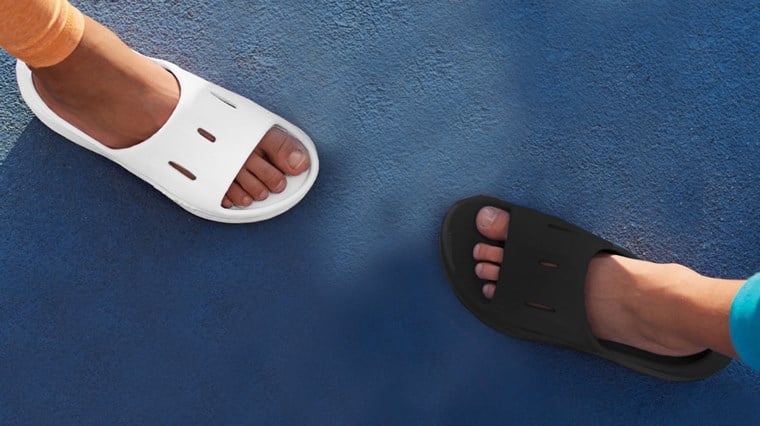
The Hoka running shoes brand emerged with the goal "to inspire people to move" at the forefront of their vision. More runners are discovering Hoka shoes every day - drawn to the brand’s signature max cushioned feel that has made Hoka running shoes such as the Hoka Bondi 8 and Hoka Clifton 9 highly recommended for individuals with plantar fasciitis.
Every Hoka shoe features a combination of key technologies, including a springy, shock-absorbing midsole, and MetaRocker to roll smoothly and efficiently into your next stride – and their recovery shoes are no different.
From the Hoka Ora Recovery Slide 3 to the Hoka Ora Mule, these recovery slides create a plush, protective barrier between your feet and the ground, reducing shock and elevating comfort. However, they don’t go overkill on softness – providing firmer cushioning so you feel supported rather than sinking into a marshmallow-soft footbed.
Thick EVA midsoles cradle your feet in luxurious support - packing the comfort-oriented tech of Hoka running shoes into their recovery-focused designs. The midsole of the Hoka Ora family is made with sugarcane EVA foam for an eco-friendly approach to cushioning. Hoka shoes compliment their resilient, shock-absorbing midsoles with wide platforms to provide stability while warding off post-run fatigue.
The early-stage MetaRocker present in Hoka recovery shoes creates a stress-reducing design, taking the strain off your feet and body during forward movement. Many plantar fasciitis sufferers have found this to be a game-changer, taking pressure off your heels to alleviate pain and support healing. Your muscles are more relaxed and your arch receives gentle support in Hoka recovery shoes.
Many marathoners and runners consider Hoka recovery shoes as “life savers” – providing relief post-training and post-racing as an essential recovery tool for everyday foot care. Alongside the winning formula of protective-yet-firm cushioning, these slip-on designs allow your feet to breathe. Whether open-toed or well-ventilated, they keep your feet in cool and healthy conditions.
-
Hoka Ora Recovery Slide 3 - Unisex Slides
-
Hoka Ora Recovery Slide 3 - Unisex Slides
-
Hoka Ora Mule - Unisex Recovery Slides
OOFOS Recovery Shoes Review: Cloud-Soft Comfort
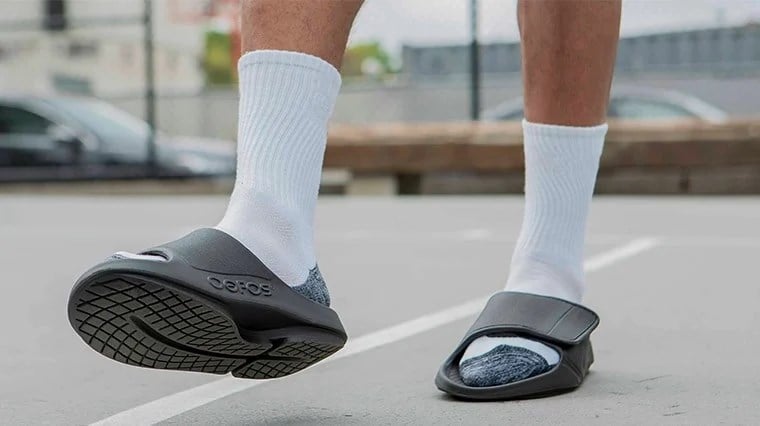
In recent years there has been a trend for athletes of all levels to take a more proactive approach to recovery - making OOFOS a brand that’s earned its time in the spotlight and then some. The brand's history in the recovery space means many runners are asking "What shoes are as good as OOFOS?", as they've set a high benchmark of comfort to compare against.
Approved by sports podiatrists, OOFOS recovery shoes are designed with shock absorption, arch support and injury prevention as priorities, taking the stress off your fatigued feet after exercise. For many everyday athletes and plantar fasciitis sufferers, they're the go-to recovery shoes to stand and walk pain-free and to return to running with your feet feeling fresh and energised.
The engineering behind their signature technology OOfoam is in an entirely different category to running shoe performance foams. Running shoe performance foams are typically designed to provide propulsion and rebound for efficient movement from foot strike to the toe-off phase of your gait transition. The compression qualities of OOfoam on the other hand (or foot) provide greater shock absorption. According to OOFOS, OOfoam absorbs 37% more impact than traditional foam.
OOfoam is designed purely for recovery to take the pressure off – not responsiveness to snap into your next stride, and the benefits aren’t isolated to your feet. Designed with your biomechanics in mind, OOFOS footwear offers a rocker-like shape, arch support and patented footbed to relieve pressure not only to your heel and forefoot, but your ankles, knees, hips and lower back.
They come in a variety of styles for recovery, walking and everyday wear that provide out-of-the-box comfort. The OOFOS OOriginal recovery thongs and OOFOS OOAHH Sport are among the most popular in the OOFOS family.
Of course, your footwear choice should be about comfort – feel over looks – but in saying that, the OOFOS OOlala and OOFOS OOlala Lux women’s recovery thongs offer a sleeker and dressier design to ensure there is an OOFOS shoe for everyone and every occasion.
-
OOFOS OOAHH Sport - Unisex Recovery Slides
-
OOFOS OOriginal - Unisex Recovery Thongs
-
OOFOS OOlala - Womens Recovery Thongs
Lightfeet Recovery Thongs: Budget-Friendly & Versatile
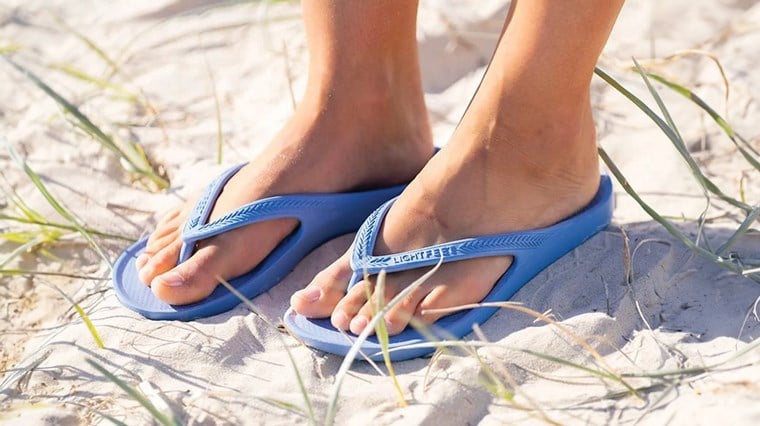
Designed by Australian sports podiatrists, Lightfeet Revive recovery thongs build upon the brand's legacy of designing cost effective and pain-relieving orthotics. Lightfeet have applied that expertise to make the recovery shoe category more approachable to runners of all abilities.
Well-known for offering one of the most popular running socks on the market - the Lightfeet Evolution - Lightfeet has earned a strong reputation for their focus on lightweight and cushioned comfort.
The Lightfeet Revive recovery thongs specifically offer a versatile, budget-friendly option that may help plantar fasciitis sufferers find much-needed relief. The combination of a shock-absorbing footbed and contoured arch support help alleviate pain and align your foot comfortably. They're also made of recycled materials to walk lighter on the planet.
The minimalist design naturally fits into your everyday wear - with a look that resembles everyday thongs, paired with a well-thought-out, stress-relieving design. As a bonus, they're available in both discreet and vibrant colours to customise your recovery and everyday wardrobe.
-
Lightfeet Revive Unisex Recovery Thongs
-
Lightfeet Revive Unisex Recovery Thongs
-
Lightfeet Revive Unisex Recovery Thongs
The Wrap Up
The health of your feet can have a dramatic effect on the quality of your performance and maintaining your motivation to lace up and enjoy an active lifestyle. From recreational runners to elite athletes, recovery shoes are paramount to support your running goals and your body in-between sessions on the road.
When comparing the top brands of recovery shoes side by side, it's clear that OOFOS recovery shoes and Hoka recovery shoes have taken a different approach based on their expertise. Each brand has a signature feel, yet deliver similar outcomes to the problem of relieving pain and preventing common running injury like plantar fasciitis.
Hoka lean into the technology of their max cushioned running shoes and transfer that into recovery shoe silhouettes - specifically their EVA midsole and MetaRocker technology. This translates to a firmer feel and support in comparison to the cloud-soft OOFOS recovery shoes.
Unlike Hoka, OOFOS don't have a focus on performance running shoe foams. Alternatively, their OOfoam is focused purely on compression qualities for maximum shock absorption. From the ground up, the goal and purpose of the entire OOFOS brand is devoted to active recovery - and they have developed numerous styles of recovery shoes to achieve this.
So the big question is, does OOFOS or Hoka top the podium in terms of recovery?
The choice between Hoka and OOFOS recovery shoes is based on your personal preference, with Hoka offering a firmer, more supportive and structured feel and OOFOS delivering pillow-soft comfort. As a third option beyond these two major competitors, Lightfeet Revive recovery thongs offer a bright and budget-friendly step in the recovery shoe category.
Whichever brand you choose, recovery shoes are a positive investment to be kind to your feet in the long-term, warding off fatigue and helping prevent or heal plantar fasciitis to keep you on track of your training.
Happy running!
If you're suffering from any chronic or reoccurring pain or injury, always seek advice from your healthcare professional.
For a more in-depth shoe fitting experience, you can book a free 15 minute video chat in a Live Fit session or make an appointment to discover your RunDNA at Sportitude Running at Hindmarsh.
Book your RunDNA assessment today!
Follow Sportitude Running at:
Instagram: sportitude.running
If you liked this, you'll love:
What Type Of Running Shoe Is Best For Me?

